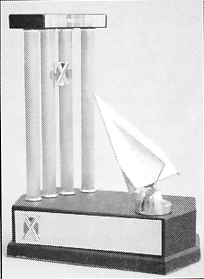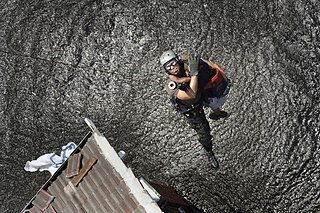
The Kaman SH-2 Seasprite is a ship-based helicopter originally developed and produced by American manufacturer Kaman Aircraft Corporation. It has been typically used as a compact and fast-moving rotorcraft for utility and anti-submarine warfare (ASW) missions. Early on it was modest sized single-engined naval utility helicopter, and progressed to twin-engine ASW and SAR, and the latest model served well into the 21st century, with G model in active service in the 2020s with Egypt, New Zealand, Peru, and Poland.

The Robert J. Collier Trophy is awarded annually for the greatest achievement in aeronautics or astronautics in America, with respect to improving the performance, efficiency, and safety of air or space vehicles, the value of which has been thoroughly demonstrated by actual use during the preceding year.

Elbert Leander "Burt" Rutan is a retired American aerospace engineer and entrepreneur noted for his originality in designing light, strong, unusual-looking, and energy-efficient air and space craft. He designed the record-breaking Voyager, which in 1986 was the first plane to fly around the world without stopping or refueling. He also designed the Virgin Atlantic GlobalFlyer, which in 2006 set the world record for the fastest and longest nonstop non-refueled circumnavigation flight in history. In 2004, Rutan's sub-orbital spaceplane design SpaceShipOne became the first privately funded spacecraft to enter the realm of space, winning the Ansari X-Prize that year for achieving the feat twice within a two-week period.

Jeana Lee Yeager is an American aviator. She co-piloted, along with Dick Rutan, the first non-stop, non-refueled flight around the world in the Rutan Voyager aircraft from December 14 to 23, 1986. The flight took 9 days, 3 minutes, and 44 seconds and covered 24,986 miles (40,211 km), almost doubling the old distance record set by a Boeing B-52 strategic bomber in 1962.

Richard Glenn Rutan was an American military aviator and officer, as well as a record-breaking test pilot who in 1986 piloted the Voyager aircraft on the first non-stop, non-refueled around-the-world flight with co-pilot Jeana Yeager. He was the older brother of famed aerospace designer Burt Rutan, whose many earlier original designs Dick piloted on class record-breaking flights, including Voyager.

Michael Winston Melvill is a world-record-breaking pilot and one of the test pilots for SpaceShipOne, the experimental spaceplane developed by Scaled Composites. Melvill piloted SpaceShipOne on its first flight past the edge of space, flight 15P on June 21, 2004, thus becoming the first commercial astronaut, and the 435th person to go into space. He was also the pilot on SpaceShipOne's flight 16P, the first competitive flight in the Ansari X Prize competition.

The Mojave Air and Space Port at Rutan Field is in Mojave, California, United States, at an elevation of 2,801 feet (854 m). It is the first facility to be licensed in the United States for horizontal launches of reusable spacecraft, being certified as a spaceport by the Federal Aviation Administration on June 17, 2004. The facility covers 2,998 acres and has three runways.

The Rutan Model 61 Long-EZ is a tandem 2-seater homebuilt aircraft designed by Burt Rutan's Rutan Aircraft Factory. The Long-EZ has a canard layout, a swept wing with wingtip rudders, and a pusher engine and propeller. The tricycle landing gear has fixed main wheels with streamlined spats and a retractable nosewheel. Its predecessor was the VariEze, plans for which were first available to homebuilders in 1976. The prototype Long-EZ, N79RA, first flew on June 12, 1979.

Francis Stanley "Gabby" Gabreski was an American career pilot in the United States Air Force who retired as a colonel after 26 years of military service. He was the top American and United States Army Air Forces fighter ace over Europe during World War II and a jet fighter ace with the Air Force in the Korean War.

The Sikorsky CH-124 Sea King is a twin-engined anti-submarine warfare (ASW) helicopter designed for shipboard use by Canadian naval forces, based on the US Navy's SH-3 Sea King. Most CH-124s were assembled in Quebec by United Aircraft of Canada. The CH-124 served with the Royal Canadian Navy (RCN) and Canadian Armed Forces from 1963 to 2018.

The Iven C. Kincheloe Award recognizes outstanding professional accomplishment in the conduct of flight testing. It was established in 1958 by the Society of Experimental Test Pilots in memory of test pilot and Korean War ace Iven C. Kincheloe, United States Air Force, who died during flight testing.

The National Aviation Hall of Fame (NAHF) is a museum, annual awards ceremony and learning and research center that was founded in 1962 as an Ohio non-profit corporation in Dayton, Ohio, United States, known as the "Birthplace of Aviation" with its connection to the Wright brothers. In 2017, the annual induction was held in Fort Worth, Texas, as the organization began rotating the ceremony among various cities.

The Sikorsky S-64 Skycrane is an American twin-engine heavy-lift helicopter. It is the civilian version of the United States Army's CH-54 Tarhe. It is currently produced as the S-64 Aircrane by Erickson Inc.

Eugene Peyton Deatrick Jr. was a United States Air Force colonel, test pilot, and combat veteran. He is best recognized for his role in the rescue of United States Navy Lieutenant Dieter Dengler during the Vietnam War. The rescue was recounted in the Werner Herzog films Little Dieter Needs to Fly and Rescue Dawn and the national bestseller Hero Found: The Greatest POW Escape of the Vietnam War by author Bruce Henderson.

The Williams V-Jet II was designed and built by Burt Rutan's Scaled Composites for Williams International as a test bed and demonstrator aircraft for Williams' new FJX-1 turbofan engine.

The 38th Rescue Squadron is an active United States Air Force Pararescue squadron. Part of the 347th Rescue Group, 23rd Wing, it is stationed at Moody Air Force Base, Georgia. The squadron flew combat search and rescue missions during the Korean War and the Vietnam War.

Jerauld Richard "Jerry" Gentry was a United States Air Force (USAF) test pilot and Vietnam combat veteran. As chief USAF pilot of the Lifting Body Research Program, he helped validate the concept of flying a wingless vehicle back to Earth from space and landing it like an aircraft—an approach used by the Space Shuttle and to a greater degree by vehicles such as the Lockheed Martin X-33 and NASA X-38. Gentry completed thirty lifting body flights including the first flight of the Martin-Marietta X-24A and the second flight of the Northrop HL-10.
The Ray E. Tenhoff Award recognizes the most outstanding technical paper presented at the annual Society of Experimental Test Pilots (SETP) Symposium in Los Angeles, California. The award was established in 1962 and is given in memory of Convair test pilot, Ray E. Tenhoff, founder and first president of SETP. Tenhoff was killed in B-58 Hustler accident on April 22, 1960.
The Living Legends of Aviation is an organization of remarkable people of extraordinary accomplishment in aviation and aerospace including: entrepreneurs, innovators, industry leaders, engineers, astronauts, record breakers, pilots who have become celebrities and celebrities who have become pilots. The Living Legends meet yearly in North America at The Beverly Hilton and in Europe every-other-year at the Scalaria Resort at a 15th century castle on the Wolfgangsee near Salzburg, Austria. Inductees and Awards are selected by the Living Legends of Aviation and by committees within the organization. These most prestigious awards are produced by and benefit the Kiddie Hawk Air Academy, a non-profit 501(c)(3).

The International Air & Space Hall of Fame is an honor roll of people, groups, organizations, or things that have contributed significantly to the advancement of aerospace flight and technology, sponsored by the San Diego Air & Space Museum. Since its founding in 1963, over 200 individuals have been inducted into the hall, with new additions inaugurated at an annual gala.


















